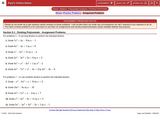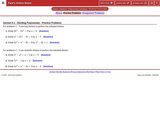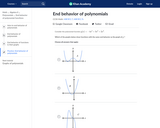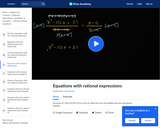
This video analyzes the mapping diagram of a function to see if the function is invertible.
- Subject:
- Mathematics
- Material Type:
- Demonstration
- Provider:
- Khan Academy
- Date Added:
- 03/16/2018

This video analyzes the mapping diagram of a function to see if the function is invertible.

Students use confidence intervals to estimate the difference of two population proportions.

In this Khan Academy activity, students will factor difference of squares problems.

In this Khan Academy activity, students will factor difference of squares problems.

This video shows how to divide two functions.

In this website they take a brief look at dividing polynomials.

More problems dividing polynomials

This video shows how to divide (x^2-3x+2) by (x-2) and then checks the solution.

Practice problems for dividing polynomials

This video shows students how to divide (2x^5-x^3+3x^2-2x+7) by (x-3) using synthetic division.

This video shows how the construction of the centroid by drawing medians divides the triangle into six smaller triangles of equal area.

This lesson will assist you in taking the quotient of the x expressions of two functions and dividing according to the rules of algebraic functioning.

Students explore a variety of mathematical functions and real world applications of functions to understand the concepts of domain and range.

Students will use statistics to determine whether there is evidence that Double Stuf Oreos have double the filling as Regular Oreos.

Plan and conduct surveys and experiments using the statistical inquiry cycle: determining appropriate variables and measures; considering sources of variation; gathering and cleaning data; using multiple displays, and re-categorizing data to find patterns, variations, relationships, and trends in multivariate data sets; comparing sample distributions visually, using measures of center, spread, and proportion; presenting a report of findings.

Students will develop, justify, and evaluate conjectures about the relationship between two quantitative variables over time in the United States: the median age (in years) when women first marry and the percentage of women aged 25-34 with a bachelor's degree or higher.

In this Khan Academy activity, students will determine what the end behavior of a polynomial looks like.

This video solves the following equation by first simplifying the rational expression: x^2-(x^2-4)/(x-2)=4

This video solves (x^2-10x+21)/(3x-12)=(x-5)/(x-4), which has one real solution and one extraneous solution.

This video solves (-2x+4)/(x-1)=3/(x+1)-1.